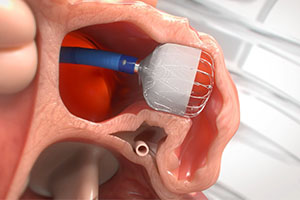- Home
- The Feature
- Abrazo Is First In Arizona To Implant New Device To Reduce Stroke Risk

Abrazo Is First In Arizona To Implant New Device To Reduce Stroke Risk
Abrazo Arizona Heart Hospital is the first in Arizona, and one of the first in the region, to perform a patient implant of the new Watchman FLX Pro left atrial appendage closure device.
The device is designed to reduce stroke risk and serve as an alternative to the lifelong use of blood thinners for people with atrial fibrillation not caused by a heart valve problem, also known as non-valvular AFib.
Some six million Americans are estimated to be affected by AFib – an irregular heartbeat that can feel like a quivering heart. People with AFib have a five times greater risk of stroke than those with normal heart rhythms.
The device closes off an area of the heart called the left atrial appendage to keep harmful blood clots that can form there from entering the blood stream and potentially causing a stroke. By closing off the left atrial appendage, the risk of stroke may be reduced and, over time, patients may be able to stop taking their blood thinner.
“The Watchman FLX Pro is the latest-generation device designed to reduce stroke risk in patients with non-valvular atrial fibrillation who need an alternative to oral anticoagulation therapy. I’m proud to have performed the first implant of this device at Abrazo Arizona Heart Hospital, as it offers another patient a potentially life-changing stroke risk treatment and will allow us to treat a broad range of patients,” said Dr. Ashish Sadhu.
Watchman technology has been implanted to treat more than 300,000 patients worldwide and is done in during a one-time procedure. The procedure is done under general anesthesia and takes about an hour. Patients commonly stay in the hospital overnight and leave the next day.
The FLX Pro features a permanent polymer coating that is designed to reduce the risk of device-related blood clots. It uses visualization markers for enhanced placement and available in a larger size to treat patients with larger left atrial appendage anatomies.
